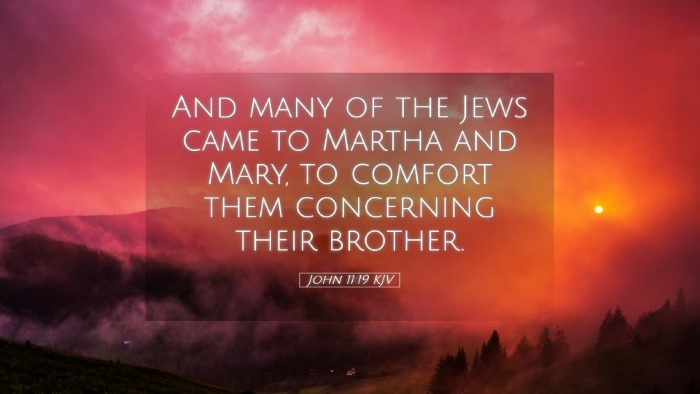Commentary on John 11:19
Verse Reference: John 11:19 - “And many of the Jews had come to Martha and Mary, to comfort them concerning their brother.”
Introduction
This verse sets a poignant stage for one of the most profound miracles performed by Jesus, the raising of Lazarus. The death of Lazarus initiated a significant gathering of mourners, illustrating the communal aspects of grief and support among the Jewish people. As we delve into this commentary, we will explore the social, emotional, and theological implications of this verse.
Contextual Analysis
The context of John 11:19 is critical for understanding the emotional weight borne by Martha and Mary. They were not only mourning the loss of their brother Lazarus but were also the focus of communal sympathy. This gathering of Jews illustrates the importance of community in times of sorrow.
- Mourners' Role: According to Jewish customs, mourning was often accompanied by a community's physical presence, as seen in this passage. These individuals were there to console the sisters, reflecting a tradition of shared grief.
- Sisterly Relationship: Martha and Mary, as sisters, were grieving together, lending strength to one another while inviting others into their mourning experience. This duality of private and public grief is essential for understanding human emotional processes.
Theological Insights
From a theological perspective, John 11:19 serves as a prelude to the demonstration of Jesus’ compassion and divine authority over death. The text emphasizes both the humanity and divinity of Christ, as well as the resurrection hope He embodies.
- Jesus as Comforter: Many commentators highlight that this verse lays groundwork for understanding Jesus’ role as a comforter. His forthcoming interactions with Martha and Mary reveal His empathy as well as His power over death.
- Foreshadowing Resurrection: The gathering signifies a moment of transition, preparing the scene where Jesus will showcase not only His ability to resurrect Lazarus but also foreshadow the resurrection offered to all believers.
Commentary from Public Domain Sources
Matthew Henry
Matthew Henry, in his exposition, emphasizes the communal aspect of grief. He notes that the coming of many Jews to comfort Martha and Mary indicates the importance of sympathy in mourning, and it shows the devastation caused by death. Henry reflects on how even amidst profound sorrow, the presence of friends provides comfort, illustrating the human need for communal support.
Albert Barnes
Albert Barnes highlights the significance of the term "comfort." He observes that the Jews came not only to share their sorrow but also to provide solace to the sisters. Barnes points out that comfort in biblical terms often involves both physical presence and spiritual reassurance, reflecting the dual role of human friendships and divine comfort in times of distress.
Adam Clarke
Adam Clarke notes the cultural practices surrounding mourning in Jewish society. He comments on the depth of emotion displayed by the people gathered, reinforcing the idea that the grief of loss is a universal experience. Clarke interprets this scene as a demonstration of the love and bonds in familial relationships, which, despite cultural differences, resonate with believers today.
Applications for Pastors and Theologians
For pastors and theologians, John 11:19 provides fruitful ground for reflection on the nature of community in bereavement. The presence of the mourners illustrates how the Body of Christ is called to bear one another's burdens (Galatians 6:2). This verse can serve as a launching point for sermons focused on:
- The Ministry of Presence: Emphasizing the importance of being present for those who are grieving, much like the many Jews did for Martha and Mary.
- Empathy and Compassion: Highlighting Jesus' eventual interaction with Martha and Mary, providing a model for empathizing with those in sorrow.
- Hope in Christ: Directing the focus towards Jesus as the source of hope and resurrection even in the darkest of circumstances.
Conclusion
John 11:19, though seemingly straightforward, reveals profound insights into the nature of communal grief and the comfort offered through relationships. It serves as a testament to the reality of loss, the need for consolation, and the hope of resurrection that Christ brings. As believers reflect on this passage, they can find encouragement in their own moments of sorrow, knowing that they are not alone, both in their experience and through the compassionate presence of Jesus.


